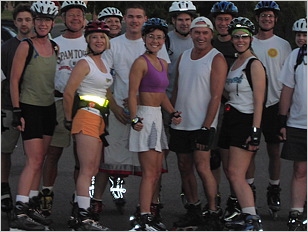 | ||||||||||||||||||||
 | ||||||||||||||||||||
| ||||||||||||||||||||
| ||||||||||||||||||||
Skate skills: This week's tip:
Illumination - Ready to roll on the Phoenix Wednesday Night Skate. By Kathy McSparran Don't let the short days of fall and winter keep you from skating. Become a night skater! Skating after the sun sets requires some extra equipment and vigilance. But it can be a whole new adventure, not to mention a great way to stay in shape. What you must think about when night skating is seeing and being seen. If you are going to be on unlit roads or trails, you'll need a headlamp to illuminate the pavement. And no matter where you skate at night, you'll need lights and reflective gear to make sure you can be seen. Seeing Here are your choices for making sure you can see where you are going: Either painstakingly scout out well-lit routes or ante up for a good quality helmet light. Don't count on a flashlight. It won't give you the light you need to spot potholes, gravel and other hazards. Two sources of quality lights are jetlites.com and niterider.com. Base your choice on:
You'll need at least a 10-watt light. And you'll find that 15- or 20-watt lights noticeably extend your field of vision. Of course, you'll pay more for light-weight and longer lasting lights. Being Seen Skaters often use a single L.E.D. red blinkie light when night skating. That's probably sufficient if you're rolling along in a group skate. When drivers see a swarm of thirty blinkies, they instinctively slow down to figure out if they are witnessing the emergence of a new species of deadly Africanized fireflies. But if you're heading out solo, a single point of red light is NOT ENOUGH. It won't provide drivers with enough visual clues to figure out what you are, nor provide enough information for them to gauge their distance from you. Aside from that, if your single blinkie is attached to your backside, it will be invisible to drivers approaching from the front (who may be about to turn into that driveway you are passing!) So for visibility, be sure to wear at least one bright multi-L.E.D. blinkie. (You can use your old single blinkie as a backup in case your battery dies on the new one.) In addition, wear light-colored clothing and reflective gear, such as vests, arm-bands and leg-bands. Make sure the reflective gear can be seen from all directions. If you don't look good in orange or yum-yum yellow, check out the way-cool IllumiNITE clothing line with tiny reflectors built right into the fabric (night-gear.com). Common Sense Even covering yourself in enough Christmas lights to set your hair on fire won’t protect you from a blind drunk or someone fishing under the seat for a cell phone. So be sure to skate defensively. Keep in mind that your head (along with your ears and eyes) is your best piece of safety gear. �--- Kathy McSparran is director of the Phoenix Inline skate school and author of the Inline Planet's Skate Coach column. She's a regular night skater (that's her in the center of the photo above). She is also a guide for Zephyr Adventures. In that role, she recently returned from a trek through the Himalayas in Tibet. Related links: • Kathy's Skate Coach Cafe
...
Copyright © 2006 by Robert Burnson | ||||||||||||||||||||



